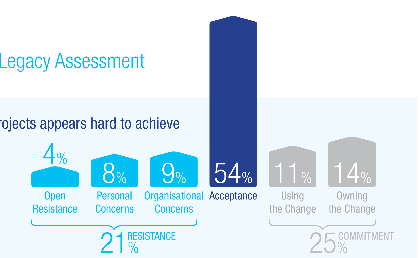
Implementing change is about people. Successful change management is not just about doing things to people (telling them, changing their teams, changing their systems) but about enabling, fostering and encouraging people to do new things. Creating that sense of engagement will result in ownership of the change which in turn drives successful change.
Without drive, too many miss out on the real benefits of change
Robin Sharma the Canadian writer and leadership speaker, best known for his The Monk Who Sold His Ferrari series, wrote that “Change is hard at first, messy in the middle and gorgeous at the end”. This is why we should never stop trying, and organisations continue to push through the pain barrier to re-invent themselves for survival and growth.
Yet there have been so many cases where the expected end state is just not achieved. Bain’s Survey of 253 large companies in 2016 tells us that only 12% of organisations get to experience that gorgeous end, and enjoy the benefits of change.

Successful organisational change is an adaptive process
It requires the coordinated efforts of a wide range of people, at all levels of the organisation who are collectively seeking the same positive outcome. Moving people to actively seek that same outcome requires a structured focus on the people in the organisation.
Change cannot be enforced, it has to be communicated, nurtured and developed until those affected are sufficiently engaged, committed and take responsibility for driving the change themselves.
Our own research tells us that at best around 25% of people in organisations become committed to change, actually using and owning the new or improved solutions. 21% of people are actively resisting change and trying to retain the status quo. That leaves a significant 54%, where change is understood and even accepted as being inevitable, but there is no sense of real engagement with the future state and its benefits.

The best engagement is driven by intrinsic motivation
In fact, the link between the best form of engagement being driven by intrinsic motivation was identified in research dating back to the 1970s. Intrinsic motivation has an important part to play in individual’s behavior because of the superior value that people attach to exploratory, playful and curiosity-driven activity, to extend and exercise their capabilities.
The four processes to create engagement
1. Communication - the primary purpose of communication is to create clarity. However, it is often overused in this sense. We generally tend to think that if messages are delivered in a logical format, then people, being rational, will buy into the message and take appropriate action to implement change.
Instead, plan communication events that give people access to, and opportunity for dialogue with, change leaders. Allow their opinions to be heard and given careful respect and consideration.
2. Involvement - control generally matters during change and involvement is the most powerful way to give people a sense of control. Plan involvement opportunities at different phases in your change project lifecycle which provide people with opportunities to challenge, control and cooperate. This in-turn promotes intrinsic motivation.
Two things to be mindful of, we must manage people’s expectations about what happens to their input, and, people need to be given the time and capacity to participate.3. Learning - most change requires new skills and attitudes that people need to learn, but effective learning during change should be about enhancing self-esteem and autonomy. Plan your learning interventions to provide:
real support for competence (not just classroom training, but optimal challenge, feedback, coaching that help people internalise new skills)
space for people to explore, practice, take risks and make mistakes
sufficient time to improve before their performance is judged.4. Recognition – trying to coordinate big/extrinsic rewards is a real challenge for project managers and change leaders. Instead, giving small rewards that are more intrinsic in nature, and aligned to specific accomplishments, can be very effective.
Build your reward plans to include clear points of recognition for:
- specific behavior change
- milestone achievement
- active involvement in the change
- the willingness to pilot new approaches to work
Intrinsic recognition sends a strong message that old ways of working and resisting change will not be rewarded. And because this type of recognition can be personalised and given at a time that is close to the event, it is also far more motivational.
Achieving success through engagement
Engagement is not special magic possessed by a few. It is a craft and a journey that needs focus and ongoing work to prevent relapse and resistance to change.
Planning and implementing the right engagement processes for your change projects will allow people to adapt, in turn increasing the level of commitment to each change. High levels of commitment turns into real ownership of the change and supports successful change management (that achievement of the gorgeous end) in your organisation.
If you are interested in more detail on these four processes, and intrinsic vs extrinsic motivation, they are all are covered further in our whitepaper, How to Actively Engage Your People in Organisational Change.
If your organisation is looking to enable, foster and encourage your people to drive successful change, you maybe interested in Roadmap Pro, our innovative transformational toolkit. It makes it quicker and easier for people to ‘learn-while-doing’ whilst providing a standardised way to communicate, involve and recognise your teams efforts and allows your business to deliver change in a cost effective way.



Leave a comment